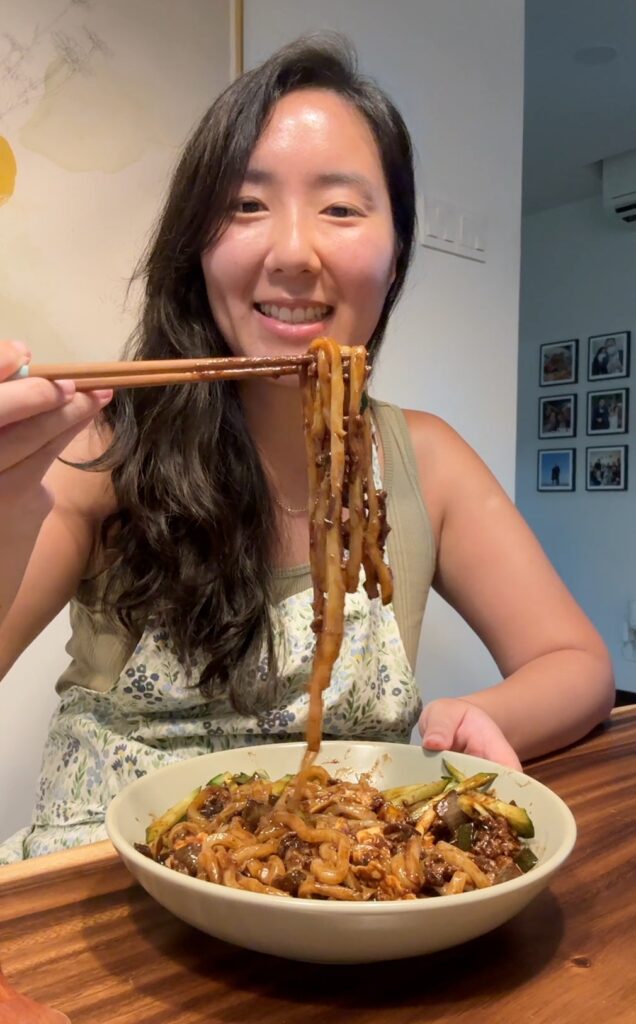


There’s something incredibly comforting about a bowl of jjajangmyeon, that glossy black bean sauce coating springy noodles, topped with fresh cucumber and maybe even a fried egg. It’s rich, savory, slightly sweet, and hits every note of nostalgic satisfaction. But beyond just being delicious, jjajangmyeon carries a story that ties together Korean history, Chinese influence, family traditions, and everyday life.

Jjajangmyeon (짜장면) actually has its roots in zhajiangmian, a dish brought to Korea by Chinese immigrants from Shandong. Over time, it evolved into something uniquely Korean, using chunjang, a fermented black bean paste, and becoming much more saucy and savory than its Chinese counterpart. Korean-Chinese restaurants became community hubs, and jjajangmyeon took center stage as their signature offering.
For many years, jjajangmyeon was more than just a meal—it was a treat. Dining out wasn’t as common back then, so this dish became something special. Families would order it for celebratory occasions, especially graduation day. A steaming bowl of jjajangmyeon marked achievement, joy, and the beginning of something new.
Today, while it’s still a comfort food, jjajangmyeon has shifted into something more everyday. It’s especially popular on moving day, when kitchens are packed up, energy is low, and you need a hearty, affordable meal. Most people just call the local Chinese-Korean joint and get it delivered because it's easy, satisfying, and guaranteed to please.

Traditional jjajangmyeon uses a specific kind of wheat-based noodle that’s chewy, bouncy, and just the right thickness. Unfortunately, these noodles can be hard to find outside of Korea. In this recipe, I used udon noodles as a substitute. While they’re not quite the same, they hold up decently under the thick sauce.
Another option is moderately thick pasta, like linguine or fettuccine. If you’re in Singapore, yellow noodles are also a good alternative. They’re convenient and accessible, though I find them less bouncy than I’d like. Whatever you use, just avoid overly thin noodles, which won’t hold the sauce well.
If you’re using a block of pork, cut it into small cubes. Minced pork also works perfectly. Chop your onion, zucchini, cabbage, and (optional) potato into bite-sized chunks. Keep the potato pieces smaller so they cook evenly.
In a large pan or pot, heat 3 tablespoons of oil over medium heat. Sauté the minced ginger and pork until the meat is about 80% cooked.
Toss in the onion, zucchini, and potato. Stir-fry until the vegetables begin to soften. Drizzle the soy sauce along the rim of the pan so it sears slightly before mixing it in. If you want a spicy kick, add a tablespoon of gochugaru here.
Make a well in the center of your pan. Add the remaining 1 tablespoon of oil and spoon in the chunjang. Let it fry for about 30 seconds to mellow out the bitterness, then mix it thoroughly with the meat and vegetables.
Add oyster sauce, sugar, water, and a pinch of MSG. Stir everything well and let it simmer for a few minutes until the flavors meld and the vegetables are fully cooked.
Stir in the cornstarch slurry and cook for another minute or two, until the sauce becomes thick and glossy. If it gets too thick, you can add a splash more water.
Spoon the sauce generously over your cooked noodles (or even rice if you prefer). Garnish with julienned cucumber and, if you like, a sunny-side-up egg on top.